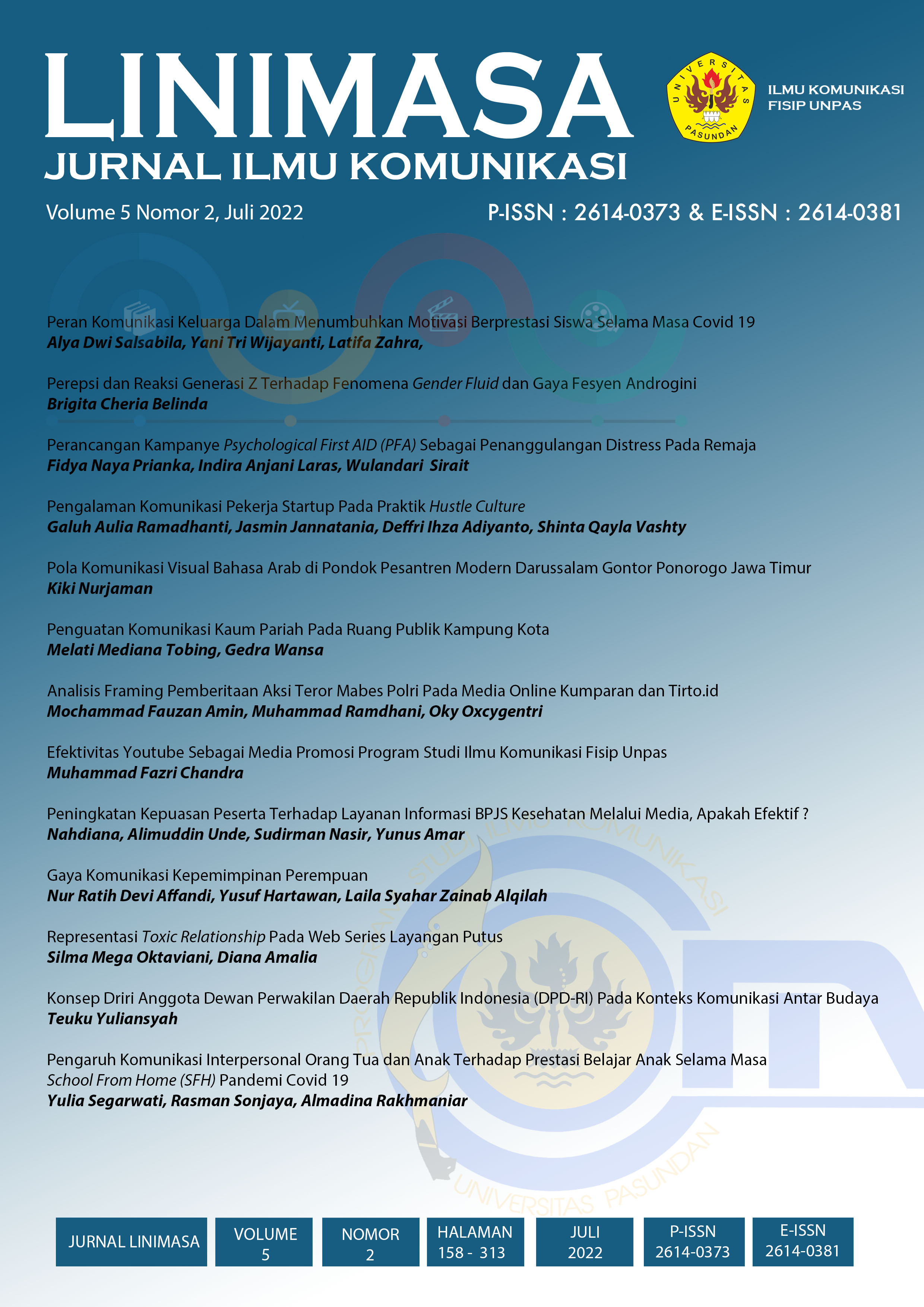PERSEPSI DAN REAKSI GENERASI Z TERHADAP FENOMENA GENDER FLUID DAN GAYA FESYEN ANDROGINI
DOI:
https://doi.org/10.23969/linimasa.v5i2.4569Keywords:
Androgynous Fashion Style, Gender fluid, Generation Z, Perception, ReactionsAbstract
ABSTRACT
The phenomenon of gender fluid and androgynous fashion style indeed exists and is rife in society. Until now this phenomenon is still receiving a lot of different perceptions and reactions from the community. The purpose of this research is to find out Generation Z's understanding of the gender fluid phenomenon through the concept of androgynous fashion style on Instagram communication media and Generation Z's reactions and perceptions of this phenomenon. Data collection is done by documentation, observation, interviews, and focus group discussions. This research is a qualitative research with descriptive methods. The results of the study show that many definitions given by Generation Z are still unclear but their understanding has begun to appear. Generation Z has different perceptions and reactions to this phenomenon. There are perceptions and reactions that are neutral,negative and positive. Even so, Generation Z has sufficiently accepted the phenomenon of gender through the concept of androgynous fashion style.
Key Word: Androgynous Fashion Style, Gender fluid, Generation Z, Perception, Reactions
Downloads
References
Abnett, K. (06 Juni 2016). Are Mixed Gender Shows the End of Men's Fashion Weeks? Retrieved 1 Juni 2021, from. https://www.businessoffashion.com/articles/fashion-week/are-mixed-gender-shows-the-end-of-mens-fashion-weeks-london-collections-men-new-york-fashion-week-mens-milan
Anindya, A. (2016). Gender Fluid Dan Identitas Androgini Dalam Media Sosial. Retrieved 10 November 2020, from http://ejournal.unp.ac.id/ index.php/tingkap/article/view/7551
Ardianto, E. (2016). Metodologi Penelitian Untuk Public Relations Kuantitatif dan Kualitatif. Bandung: Simbiosa Rekatama Media.
Codrington, G. T., & Grant-Marshall, S. (2011). Mind the Gap. Johannesburg: Penguin Books.
Creswell, J. W. (2007). Qualitative inquiry and research design: Choosing among five traditions(2nd ed.). Thousand Oaks, California: SAGE Publications.
Cronn-Mills, K. (2014). Transgender Lives: Complex Stories, Complex Voices. Minneapolis: Twenty-First Century Books.
Fourhooks. (2015, April 26). The Generation Guide - Millennials, Gen X, Y, Z and Baby Boomers. Retrieved 11 Juni 2021, from http://fourhooks.com/marketing/the-generation-guide-millennials-gen-x-y-z-and-baby-boomers-art5910718593/
Gauntlett, D. (2002). Media, gender and identity: An introduction. London: Routledge.
Guastello, D. D., & Guastello, S. J. (2003). Androgyny, Gender Role Behavior, and Emotional Intelligence Among College Students and Their Parents. Sex Roles, 49(11/12), 663-673. doi:10.1023/b:sers.0000003136.67714.04
Hafkin, N. (2002). Gender Issues in ICT Policy in Developing Countries: An Overview. Division for the Advancement of Women (DAW) Expert Group Meeting on “Information and Communication Technologies and Their Impact on and Use as an Instrument for the Advancement and Empowerment of Women” Seoul, Republic of Korea 11 to 14 November 2002, 1, 11-14. Retrieved 5 Juni 2021, from https://www.un.org/womenwatch/daw/egm/ict2002/reports/Paper-NHafkin.PDF.
Hamenda, R. O. (2012). Representation of Androgyny Fashion in Fashion Page in Elle Magazine Indonesia: A Semiotic Study. Retrieved 9 Desember 2020, from http://www.journal.unair.ac.id/filerPDF/07.Reza Oktivia Hamenda-Allusion Vol 01 No 01 - Februari 2012.pdf
Hammersley, M. (2012). What is Qualitative Research?London: Bloomsbury Publishing.
Kark, R., Waismel-Manor, R., & Shamir, B. (2012). Does valuing androgyny and femininity lead to a female advantage? The relationship between gender-role, transformational leadership and identification. The Leadership Quarterly, 23(3), 620-640. doi:10.1016/j.leaqua.2011.12.012
Liem, H., Githapradana, D. M., & Purnomo, J. (2020). Style Androgini Sebagai Wujud Genderless Fashion. Diambil pada 01 Juni 2021, dari https://www.uc.ac.id/envisi/wp-content/uploads/publikasifpd/ENVISIFPD-2020-P137-HILLARY LIEM, DEWA MADE WEDA GITHAPRADANA, JENNIFER PURNOMO-STYLE ANDROGINI SEBAGAI WUJUD GENDERLESS FASHION.pdf.
Mcgregor, J., & Tweed, D. (2001). Gender and managerial competence: Support for theories of androgyny? Women in Management Review,16(6), 279-287. doi:10.1108/09649420110401540
Miles, M. B., & Huberman, A. M. (1994). Qualitative data analysis (2nd ed.). Thousand Oaks: Sage.
Nila, A. (4 April 2019). 'The Future is Female': When Feminism, fashion collide. Diambil dari https://www.thejakartapost.com/life/2019/04/04/the-future-is-female-when-feminism-fashion-collide.html
Notjustalabel.com. (2021). Moral. Retrieved 1 Mei 2021, from https://www.notjustalabel.com/moral
Notoatmodjo, S., 2003. Pendidikan Dan Perilaku Kesehatan. Jakarta: Rineka Cipta.
Pambudi, N. S., Haldani, A., & Adhitama, G. P. (2019). Studi Preferensi Masyarakat Jakarta Terhadap Genderless Fashion. Jurnal Rupa, 4(1), 54. doi:10.25124/rupa.v4i1.2249
Saintyork.co. (2021). About Us. Retrieved 1 Mei 2021, from https://saintyork.co/pages/about-us
Samsu, S.Ag., M.Pd.I., Ph.D. (2017). METODE PENELITIAN: (Teori dan Aplikasi Penelitian Kualitatif, Kuantitatif, Mixed Methods, serta Research & Development)(1st ed.). Jakarta: Pusat Studi Agama dan Kemasyarakatan (PUSAKA)
Setyaningsih, N. R. (2009, March 25). Studi deskriptif tentang androgenitas pada mahasiswa fakultas psikologi Universitas Sanata Dharma. Diambil pada 1 Mei 2021, dari http://repository.usd.ac.id/id/eprint/28140
Shadily, H. (1991). Ensiklopedia Umum. Yogyakarta: Kanisius.
Sihombing, H. L., & Rakhmad, W. N. (2019). Pemaknaan Khalayak Terhadap Androgini Pada Akun Instagram Andreas Lukita. Jurnal Interaksi Online,7(4), 350-360. Retrieved June 20, 2021, from https://ejournal3.undip.ac.id/index.php/interaksi-online/article/view/24955.
Sobur, A. (2003). Psikologi Umum. Bandung: Pustaka Setia.
Suranto, A. W. (2011). Komunikasi Interpersonal. Yogyakarta: Graha Ilmu.
Supratiknya, A. (2015). Metode Kuantitatif & Kualitatif dalam Psykologi. Sleman, Yogyakarta: Universitas Sanata Dharma.
Vehviläinen, M., & Brunila, K. (2007). Cartography Of Gender Equality Projects In Ict: Liberal Equality From The Perspective Of Situated Equality. Information, Communication & Society,10(3), 384-403. doi:10.1080/13691180701410067
Wagner, J. A., & Hollenbeck, J. R. (1995). Management of organizational behavior. Englewood Cliffs, NJ: Prentice-Hall.
Widyatama, R. (2006). Bias gender dalam iklan televisi. Yogyakarta: Media Pressindo.















